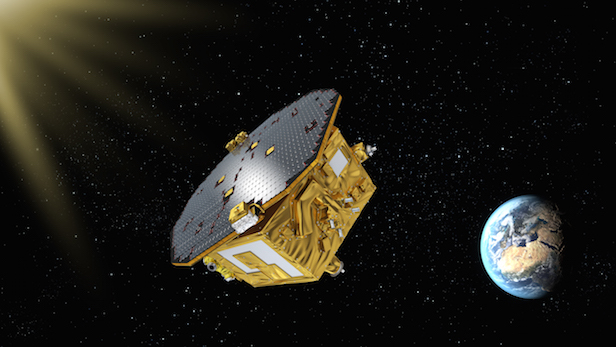LISA Pathfinder to be used as ‘comet crumb’ detector
The mission has successfully demonstrated critical technologies needed to build a space-based observatory capable of detecting slight ripples in space-time
LISA Pathfinder, a mission led by the European Space Agency (ESA) with contributions from NASA, has successfully demonstrated critical technologies needed to build a space-based observatory for detecting ripples in space-time called gravitational waves. Now a team of NASA scientists hopes to take advantage of the spacecraft’s record-breaking sensitivity to map out the distribution of tiny dust particles shed by asteroids and comets far from Earth.
Most of these particles have masses measured in micrograms, similar to a small grain of sand. But with speeds greater than 36,000 kilometres per hour (22,000 miles per hour), even micrometeoroids pack a punch. The new measurements could help refine dust models used by researchers in a variety of studies, from understanding the physics of planet formation to estimating impact risks for current and future spacecraft.
“We’ve shown we have a novel technique and that it works,” says Ira Thorpe, who leads the team at NASA’s Goddard Space Flight Center in Greenbelt, Maryland. “The next step is to carefully apply this technique to our whole data set and interpret the results.”
The mission’s primary goal was to test how well the spacecraft could fly in formation with an identical pair of 46-millimetre (1.8-inch) gold-platinum cubes floating inside it. The cubes are test masses intended to be in free fall and responding only to gravity.
The spacecraft serves as a shield to protect the test masses from external forces. When LISA Pathfinder responds to pressure from sunlight and microscopic dust impacts, the spacecraft automatically compensates by firing tiny bursts from its micronewton thrusters to prevent the test masses from being disturbed.
Scientists call this drag-free flight. In its first two months of operations in early 2016, LISA Pathfinder demonstrated the process with a precision some five times better than its mission requirements, making it the most sensitive instrument for measuring acceleration yet flown. It has now reached the sensitivity level needed to build a full multi-spacecraft gravitational-wave observatory.
“Every time microscopic dust strikes LISA Pathfinder, its thrusters null out the small amount of momentum transferred to the spacecraft,” says Goddard co-investigator Diego Janches. “We can turn that around and use the thruster firings to learn more about the impacting particles. One team’s noise becomes another team’s data.”
Much of what we know about interplanetary dust is limited to Earth’s neighbourhood, thanks in large part to NASA’s Long Duration Exposure Facility (LDEF). Launched into Earth orbit by space shuttle Challenger in April 1984 and retrieved by space shuttle Columbia in January 1990, LDEF hosted dozens of experiments, many of which were designed to better understand the meteoroid and orbital debris environment.
The different compositions, orbits and histories of different asteroids and comets naturally produce dust with a range of masses and velocities. Scientists suspect the smallest and slowest particles are enhanced in Earth’s neighbourhood, so the LDEF results are not representative of the wider Solar System.
“Small, slow particles near a planet are most susceptible to the planet’s gravitational pull, which we call gravitational focusing,” Janches says. This means the micrometeoroid flux near Earth should be much higher than that experienced by LISA Pathfinder, located about 1.5 million kilometres (930,000 miles) closer to the Sun.
To find the impacts, Tyson Littenberg at NASA’s Marshall Space Flight Center in Huntsville, Alabama, adapted an algorithm he originally developed to search for gravitational waves in data from the ground-based detectors of the Laser Interferometer Gravitational-wave Observatory (LIGO), located in Livingston, Louisiana, and Hanford, Washington. In fact, it was one of many algorithms that played a role in the discovery of gravitational waves by LIGO, announced in February 2016.
“The way it works is that we come up with a guess of what the signal might look like, then study how LIGO or LISA Pathfinder would react if this guess were true,” Littenberg explains. “For LIGO, we’re guessing about the waveform, the peaks and valleys of the gravitational wave. For LISA Pathfinder, we’re guessing about an impact.”
To map out the probability of likely sources, the team generates millions of different scenarios describing what the source might be and compares them to what the spacecraft actually detects.
In response to an impact, LISA Pathfinder fires its thrusters to counteract both the minute ‘push’ from the strike and any change in the spacecraft’s spin. Together, these quantities allow the researchers to determine the impact’s location on the spacecraft and reconstruct the micrometeoroid’s original trajectory. This may allow the team to identify individual debris streams and perhaps relate them to known asteroids and comets.
“This is a very nice collaboration,” says Paul McNamara, the LISA Pathfinder project scientist at ESA’s Directorate of Science in Noordwijk, the Netherlands. “This is data we use for doing our science measurements, and as an offshoot of that, Ira and his team can tell us about microparticles hitting the spacecraft.”
Its distant location, sensitivity to low-mass particles, and ability to measure the size and direction of impacting particles make LISA Pathfinder a unique instrument for studying the population of micrometeoroids in the inner Solar System. But it’s only the beginning.
“This is a proof of concept, but we’d hope to repeat this technique with a full gravitational-wave observatory that ESA and NASA are currently studying for the future,” says Thorpe. “With multiple spacecraft in different orbits and a much longer observing time, the quality of the data should really improve.”
Keep up to date with the latest space news in All About Space – available every month for just £4.99. Alternatively you can subscribe here for a fraction of the price!





